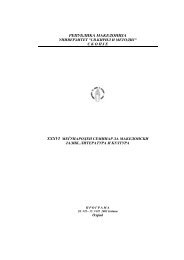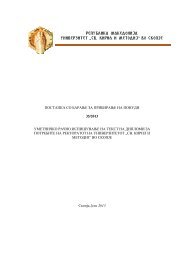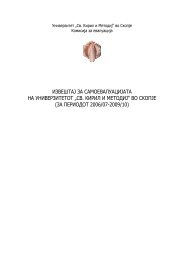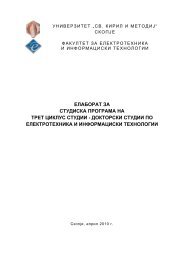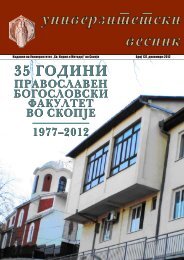УНИВЕРЗИТЕТ „СВ. КИРИЛ И МЕТОДИЈ“ – СКОПЈЕ
УНИВЕРЗИТЕТ „СВ. КИРИЛ И МЕТОДИЈ“ – СКОПЈЕ
УНИВЕРЗИТЕТ „СВ. КИРИЛ И МЕТОДИЈ“ – СКОПЈЕ
Create successful ePaper yourself
Turn your PDF publications into a flip-book with our unique Google optimized e-Paper software.
160<br />
centuation in the Greek orthography is also used to denote word stress; however,<br />
the accent cannot be written further than on the antepenultimate syllable. It is<br />
possible that in the target language of the Konikovo Gospel, there are words<br />
that actually have a stress that falls further from the end of the word than on<br />
the antepenultimate syllable.<br />
All in all, the writer follows fairly dutifully the Greek graphotactics in<br />
the deployment of the acute accent and the circumflex. Still, the accent is sometimes<br />
written further from the end of the word than the Greek graphotactics<br />
would permit. One interesting example is the word mágaricata. The accent in<br />
this word is written on the fifth syllable from the end of the word. A few pages<br />
later, the same word occurs again, but here it is written as magarícata. In the<br />
latter case, the place of the accent is in concord with the Greek graphotactics.<br />
Another example of the problems of accentuation is the recurrent phrase<br />
Učenícité mu. The question is whether the accentuation here represents the<br />
actual stresses of the target language or merely the influence of the Greek graphotactics.<br />
The Greek orthography does have a rule such that when a clitic pronoun<br />
follows the headword that has an accent on the antepenultimate syllable,<br />
a secondary accent is written on the ultimate syllable of the headword.<br />
Moreover, many of the prepositions are accented in the text. For instance,<br />
the following prepositions are regularly written with an accent: sôs, ná and zá.<br />
In theory, this could be explained by the fact that the preposition sometimes can<br />
belong to a “phonetic word” together with the main word and can be stressed<br />
in speech. Nevertheless, it is more likely that the accentuation of monosyllabic<br />
clitics in general does not reflect the stress of the words, but, again, the spirit<br />
of the Greek writing system.<br />
As it is clear from these aforementioned observations, it is not reasonable<br />
to assume that all of the accents actually represent the word stress of the target<br />
language, even if, for the most part, that were the case. Most of the variation and<br />
vacillation occurs in words that have either one or more than three syllables.<br />
3.3. The Second Hand<br />
A large part of the corrections made to the text by the second hand consists<br />
of “restoring” the reduced vowels to their unreduced forms. This involves<br />
the reductions /o/ > /u/ and /e/ > /i/. One of the most typical corrections is<br />
changing the verb béši into béše. At times, the second hand also replaces whole<br />
words. The graphemic principles of the second hand are most visible in these<br />
instances. As a general rule, these principles are similar to those of the first<br />
hand; however, the second hand does not write accents as regularly.






